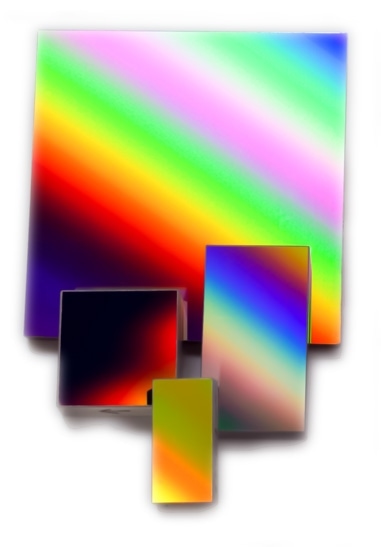Stock Diffraction Gratings
Diffraction gratings are significant in facilitating transmission or reflection in optical applications. At OPCO Laboratories Inc., we have more than 40 years of optical manufacturing experience. Our experts can assist you in determining which grating best meets the requirements of your project.
Benefits of Stock Diffraction Gratings
Even though stock diffraction grating masters are based on decades-old designs, many are still in operation today. For instance, replicated diffraction gratings can be found in modern monochromators, spectrometers, and other optical devices that use standard parts. Grating masters also help produce stock diffraction gratings that provide high efficiency at lower costs. Replicating grating masters eliminates expenses associated with custom tooling, a requirement for creating custom diffraction grating masters.
Stock diffraction gratings offer a variety of benefits, including:
- Linear wavelength dispersion
- No absorption issues
- Increased efficiency
- Cost-effectiveness
Our engineers and technicians have helped customers overcome spectrometer design obstacles by providing them with affordable components like replicated diffraction gratings.
For more information, read our blog article found on our resource page Stock / Standard vs Custom Diffraction Gratings
Replicated Diffraction Gratings From Existing Grating Masters
In the 1940s, new technology allowed manufacturers to replicate master gratings onto other substrates, resulting in high-efficiency, cost-effective optical solutions. Master gratings are first-run diffraction gratings refined to a final product.
Before the development of efficient replication techniques, all diffraction gratings were simply master gratings. This practice was difficult and time-consuming due to variations in groove size, spacing, and other flaws that could result in out-of-spec gratings. Thanks to replication technology, replicas are nearly identical to the master, exhibiting the same size, shape, and topography without the labor-intensive process.
Replication Process for Diffraction Gratings
Compared to producing a new grating master every time, it is much easier to replicate diffraction gratings from a master grating. The process begins with the fabrication and verification of a master grating, followed by applying a releasing agent to its surface. On top of this goes the epoxy and the replica substrate. The epoxy is cured and the replica is released. Unless it is a transmission grating, a reflective coating should be added to the surface of the replica. Replicating from an existing grating master is ideal for lowering costs incurred by custom tooling.
Using high-quality epoxies, substrates, and coatings, this technique yields excellent diffraction gratings that have minimal deviation from the existing master grating.
Groove Density and Blaze Wavelength
Groove density is the measurement of the internal angles between the zero-order and first-order diffraction gratings for two distinct wavelengths with the same incidence angles.
Blaze wavelength is the wavelength at which the diffraction efficiency curve achieves its maximum for a specific order. It is determined by the shape of the grating and reveals its overall effectiveness.
Our Stock Grating Efficiency Curves
This list is a representative sample of our grating efficiency curves at various groove densities and blaze wavelengths. Scroll down the list or re-sort it by column, click on the graph icon to see the efficiency curve.
Contact Ryan at OPCO with questions about our diffraction grating capabilities or to get started on your next project.
Ruled Diffraction Gratings
Echelle Gratings
| Catalog Number | Groove Density (lines per millimeter) | Blaze Angle |
|---|---|---|
| 3007 | 52.91 | 63.50 |
| 3009 | 52.91 | 63.50 |
| 3019 | 20 | 10.6 |
| 3020 | 46 | 68.00 |
| 3010 | 52.91 | 63.50 |
| 3022 | 48.39 | 68.20 |
| 3025 | 52.676 | 70.00 |
| 3036A | 49.7 | 69.15 |
| 3036 | 49.7 | 68.90 |
| 3037 | 49.7 | 69.50 |
| 3044 | 52.91 | 63.50 |
Diffraction Gratings from OPCO Laboratory, Inc.
OPCO Laboratory’s cutting-edge ruling engine demonstrates our dedication to the analytical instrument sector. This engine was created by and for spectroscopists. Our vertical integration guarantees that we can control the entire process, including design, production, coating, testing, and assembly.
We provide on-time, high-quality optical solutions for many critical sectors, such as aerospace, defense, life sciences, semiconductor, and spectroscopy. Contact us to learn more about our grating capabilities, or request a quote for your solution.
